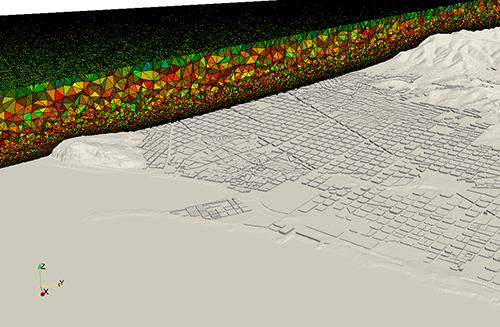Researchers at Barcelona Supercomputing Center (BSC) are working towards a first working version of a tool which allows the integration of data in different formats in order to make Barcelona a smarter city. Specifically, the tool will facilitate greater energy efficiency, improved sustainability in urban transportation and greater infrastructural integration.
Jorge García Vidal, senior associate researcher in smart cities at the supercomputing centre, estimates that a first working version of the tool will most likely be ready by the autumn. Data generated within a city tend to have heterogeneous origins, including structured and semi-structured data, raw data and data in different formats, and differ from city to city. In order to make intelligent and coherent use of such data, tools known as ontologies are created to represent the information semantically.
For Jorge García Vidal, ‘the use of information and communication technologies can help to change how systems of production, transport and so on are organised, and to modify our day-to-day habits. These changes towards a sustainable economic system are essential if future societies are to benefit from the standards of wellbeing which we’re used to’.
BSC has been working on extending an existing ontology so that it can be applied in the fields of energy and transportation. It includes categories in common (events and messages, stakeholders, departments, services, city landmarks and resources, key performance indicators…), extensions for each area and customisable elements for individual cities.
This research task is being carried out as part of the GrowSmarter project, which has been awarded €25 million within the European Union’s Horizon 2020 programme (Smart Cities and Communities lighthouse projects). GrowSmarter brings together cities and industry stakeholders to integrate and demonstrate 12 smart city solutions in the areas of energy, infrastructure and transport. Three cities within the project act as ‘lighthouse cities’, with the aim of offering practical information and examples to follow for other cities. The lighthouse cities are Barcelona, Cologne and Stockholm.
BSC is also working on another facet within the GrowSmarter project: air quality at the urban scale. Currently, air quality forecasts take place at the mesoscale, that is, using horizontal resolutions of several kilometres. BSC aims to obtain these predictions almost at the scale of individual streets. However, to achieve this, much higher resolution wind forecasts than those which are currently available are necessary, as well as an inventory of emissions with frequently updated data about pollutants.
The researcher leading this part of the project, Arnau Folch, explains that the final result is achieved by ‘combining high-resolution simulations (at the street level) with wind and pollutant data, using a methodology which can be replicated in other cities’.
At this initial stage of the project, a computational mesh has been produced for Barcelona which collects and combines land registry data with data relating to topography and heights taken with LIDAR. The mesh was created by BSC researcher Abel Gargallo, and work is currently being undertaken on simulating winds at the street level.




The projects grouped under the Lighthouse initiative represent the European Union’s firm commitment to solving challenges in urban communities. A total of 78% of European citizens live in cities; they represent 85% of the EU’s gross domestic product and consume 70% of its energy.
Following the cities of Barcelona, Cologne and Stockholm are Cork, Graz, Valletta, Porto and Suceava, which will learn from the lighthouse cities’ experience and bring market solutions to their local area.
About GrowSmarter
The GrowSmarter project aims to promote the take-up of smart technologies, develop partnerships between businesses and cities and create sustainable, more liveable European cities which respond to their inhabitants’ needs.
The three lighthouse cities are rolling out a series of smart technologies in energy, infrastructure and transport, designed to save energy and lead to self-sufficiency in urban districts. They will also help other cities to implement these solutions with valuable information gained through their experience.
Press release in English.
Nota de prensa en español.
Nota de premsa en català.
